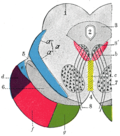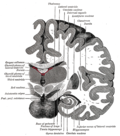Lentiform nucleus
Lentiform nucleus is a component of the basal ganglia in the brain. It is a large, lens-shaped mass of grey matter that is located in the cerebrum on either side of the thalamus. The lentiform nucleus is divided into two sections: the putamen and the globus pallidus.
Structure[edit]
The lentiform nucleus is a bilateral structure in the brain that is divided into two parts: the putamen and the globus pallidus. The putamen is the outermost portion of the lentiform nucleus, while the globus pallidus is located internally. The globus pallidus itself is divided into two segments: the globus pallidus externus and the globus pallidus internus.
Function[edit]
The lentiform nucleus plays a crucial role in the regulation of voluntary movement. It is part of the motor circuit of the basal ganglia, which is involved in the planning and execution of movement. The lentiform nucleus also contributes to cognitive and emotional functions.
Clinical significance[edit]
Damage to the lentiform nucleus can result in a variety of movement disorders, including Parkinson's disease and Huntington's disease. In Parkinson's disease, there is a loss of dopamine-producing cells in the putamen, which leads to the characteristic symptoms of the disease. In Huntington's disease, there is a loss of cells in the globus pallidus, which results in uncontrolled movements.
See also[edit]
References[edit]
<references />
|
|
|
-
Coronal section of brain showing the lentiform nucleus
-
Horizontal section of brain showing the lentiform nucleus
-
Sagittal section of brain showing the lentiform nucleus
-
Lentiform nucleus in relation to the internal capsule
-
Lentiform nucleus in a transverse section of the brain
-
Lentiform nucleus in a coronal section of the brain
-
Lentiform nucleus in a horizontal section of the brain
-
Lentiform nucleus
-
Lentiform nucleus
Ad. Transform your life with W8MD's Budget GLP-1 injections from $75


W8MD offers a medical weight loss program to lose weight in Philadelphia. Our physician-supervised medical weight loss provides:
- Weight loss injections in NYC (generic and brand names):
- Zepbound / Mounjaro, Wegovy / Ozempic, Saxenda
- Most insurances accepted or discounted self-pay rates. We will obtain insurance prior authorizations if needed.
- Generic GLP1 weight loss injections from $75 for the starting dose.
- Also offer prescription weight loss medications including Phentermine, Qsymia, Diethylpropion, Contrave etc.
NYC weight loss doctor appointmentsNYC weight loss doctor appointments
Start your NYC weight loss journey today at our NYC medical weight loss and Philadelphia medical weight loss clinics.
- Call 718-946-5500 to lose weight in NYC or for medical weight loss in Philadelphia 215-676-2334.
- Tags:NYC medical weight loss, Philadelphia lose weight Zepbound NYC, Budget GLP1 weight loss injections, Wegovy Philadelphia, Wegovy NYC, Philadelphia medical weight loss, Brookly weight loss and Wegovy NYC
|
WikiMD's Wellness Encyclopedia |
| Let Food Be Thy Medicine Medicine Thy Food - Hippocrates |
Medical Disclaimer: WikiMD is not a substitute for professional medical advice. The information on WikiMD is provided as an information resource only, may be incorrect, outdated or misleading, and is not to be used or relied on for any diagnostic or treatment purposes. Please consult your health care provider before making any healthcare decisions or for guidance about a specific medical condition. WikiMD expressly disclaims responsibility, and shall have no liability, for any damages, loss, injury, or liability whatsoever suffered as a result of your reliance on the information contained in this site. By visiting this site you agree to the foregoing terms and conditions, which may from time to time be changed or supplemented by WikiMD. If you do not agree to the foregoing terms and conditions, you should not enter or use this site. See full disclaimer.
Credits:Most images are courtesy of Wikimedia commons, and templates, categories Wikipedia, licensed under CC BY SA or similar.
Translate this page: - East Asian
中文,
日本,
한국어,
South Asian
हिन्दी,
தமிழ்,
తెలుగు,
Urdu,
ಕನ್ನಡ,
Southeast Asian
Indonesian,
Vietnamese,
Thai,
မြန်မာဘာသာ,
বাংলা
European
español,
Deutsch,
français,
Greek,
português do Brasil,
polski,
română,
русский,
Nederlands,
norsk,
svenska,
suomi,
Italian
Middle Eastern & African
عربى,
Turkish,
Persian,
Hebrew,
Afrikaans,
isiZulu,
Kiswahili,
Other
Bulgarian,
Hungarian,
Czech,
Swedish,
മലയാളം,
मराठी,
ਪੰਜਾਬੀ,
ગુજરાતી,
Portuguese,
Ukrainian












